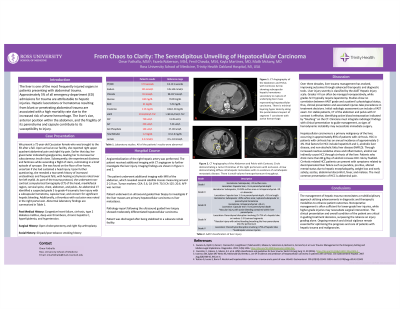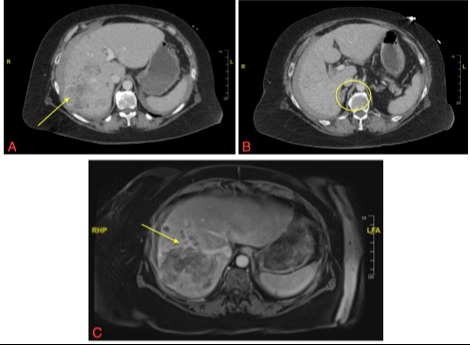Monday Poster Session
Category: Liver
P3125 - From Chaos to Clarity: The Serendipitous Unveiling of Hepatocellular Carcinoma
Monday, October 28, 2024
10:30 AM - 4:00 PM ET
Location: Exhibit Hall E

Has Audio

Omar Fathalla, MS
Ross University School of Medicine
Pontiac, MI
Presenting Author(s)
Omar Fathalla, MS1, Fenil Chavda, MS1, Fazela Roberson, MS1, Kayla Martinez, MD2, Malik McKany, MD3
1Ross University School of Medicine, Pontiac, MI; 2Detroit Medical Center/Wayne State University, Detroit, MI; 3Trinity Health Oakland / Wayne State University School of Medicine, Pontiac, MI
Introduction: The liver is one of the most frequently injured organs in patients presenting with abdominal trauma. Approximately 5% of all emergency department (ED) admissions for trauma are attributable to hepatic injuries. Hepatic lacerations or hematomas resulting from blunt or penetrating abdominal trauma are associated with a high mortality rate due to the increased risk of severe hemorrhage. The liver's size, anterior position within the abdomen, and the fragility of its parenchyma and capsule contribute to its susceptibility to injury.
Case Description/Methods: We present a 72-year-old Caucasian female with a history of lower extremity DVT, type 2 diabetes mellitus, and hyperlipidemia. She presented with right upper quadrant abdominal pain and right hip pain. Earlier that day, her glucometer showed hyperglycemia, prompting her to increase her insulin dose. She then felt faint while climbing stairs, leading to a brief syncopal episode. She was found on her home's floor, unsure if she hit her head. While in the ED, trauma protocol included a CT of the head, maxillofacial area, cervical spine, chest, abdomen, and pelvis. Abdominal CT revealed a grade III to IV traumatic liver injury with a subcapsular hematoma, capsular tear, and severe hepatic bleeding. A thrombus with occlusion was found in the right portal vein. Angioembolization of the right hepatic artery was performed. Intraoperative hepatic biopsy showed moderately differentiated hepatocellular carcinoma (HCC). The patient was ineligible for liver transplantation and was scheduled for immunotherapy. Initial abnormal laboratory and imaging findings are summarized in Table 1 and Image 1, respectively.
Discussion: Over three decades, liver trauma management has evolved, improving outcomes through advanced therapeutic and diagnostic tools. Liver injury severity is classified by the AAST Hepatic Injury scale. Grades I-III can often be managed nonoperatively, while grades IV-V typically require laparotomy. Studies show no correlation between AAST grade and a patient’s physiological status; thus, clinical presentation and associated injuries take precedence in treatment decisions. Initial radiologic assessment can include a FAST exam. For stable patients, CT of the abdomen and pelvis with IV contrast is effective, identifying active blood extravasation indicated by “blushing” on the CT. Clinicians must integrate radiologic findings with clinical presentation to guide management, as signs of hemodynamic instability may necessitate immediate surgery.

Note: The table for this abstract can be viewed in the ePoster Gallery section of the ACG 2024 ePoster Site or in The American Journal of Gastroenterology's abstract supplement issue, both of which will be available starting October 27, 2024.
Disclosures:
Omar Fathalla, MS1, Fenil Chavda, MS1, Fazela Roberson, MS1, Kayla Martinez, MD2, Malik McKany, MD3. P3125 - From Chaos to Clarity: The Serendipitous Unveiling of Hepatocellular Carcinoma, ACG 2024 Annual Scientific Meeting Abstracts. Philadelphia, PA: American College of Gastroenterology.
1Ross University School of Medicine, Pontiac, MI; 2Detroit Medical Center/Wayne State University, Detroit, MI; 3Trinity Health Oakland / Wayne State University School of Medicine, Pontiac, MI
Introduction: The liver is one of the most frequently injured organs in patients presenting with abdominal trauma. Approximately 5% of all emergency department (ED) admissions for trauma are attributable to hepatic injuries. Hepatic lacerations or hematomas resulting from blunt or penetrating abdominal trauma are associated with a high mortality rate due to the increased risk of severe hemorrhage. The liver's size, anterior position within the abdomen, and the fragility of its parenchyma and capsule contribute to its susceptibility to injury.
Case Description/Methods: We present a 72-year-old Caucasian female with a history of lower extremity DVT, type 2 diabetes mellitus, and hyperlipidemia. She presented with right upper quadrant abdominal pain and right hip pain. Earlier that day, her glucometer showed hyperglycemia, prompting her to increase her insulin dose. She then felt faint while climbing stairs, leading to a brief syncopal episode. She was found on her home's floor, unsure if she hit her head. While in the ED, trauma protocol included a CT of the head, maxillofacial area, cervical spine, chest, abdomen, and pelvis. Abdominal CT revealed a grade III to IV traumatic liver injury with a subcapsular hematoma, capsular tear, and severe hepatic bleeding. A thrombus with occlusion was found in the right portal vein. Angioembolization of the right hepatic artery was performed. Intraoperative hepatic biopsy showed moderately differentiated hepatocellular carcinoma (HCC). The patient was ineligible for liver transplantation and was scheduled for immunotherapy. Initial abnormal laboratory and imaging findings are summarized in Table 1 and Image 1, respectively.
Discussion: Over three decades, liver trauma management has evolved, improving outcomes through advanced therapeutic and diagnostic tools. Liver injury severity is classified by the AAST Hepatic Injury scale. Grades I-III can often be managed nonoperatively, while grades IV-V typically require laparotomy. Studies show no correlation between AAST grade and a patient’s physiological status; thus, clinical presentation and associated injuries take precedence in treatment decisions. Initial radiologic assessment can include a FAST exam. For stable patients, CT of the abdomen and pelvis with IV contrast is effective, identifying active blood extravasation indicated by “blushing” on the CT. Clinicians must integrate radiologic findings with clinical presentation to guide management, as signs of hemodynamic instability may necessitate immediate surgery.

Figure: Image 1: CT Angiography of the Abdomen and Pelvis with Contrast; A: Arrow showing subcapsular hepatic hematoma secondary to rupture of underlying liver mass representing hepatocellular carcinoma. There is minimal layering hyperdensity along the posterolateral aspect of segment 7 consistent with active hemorrhage. B: Circle demonstrating a tumor thrombus of the right portal vein with occlusion. C: Arrow demonstrating diffuse intrahepatic metastases with no evidence of extrahepatic metastatic disease. There is small volume hemoperitoneum throughout.
Note: The table for this abstract can be viewed in the ePoster Gallery section of the ACG 2024 ePoster Site or in The American Journal of Gastroenterology's abstract supplement issue, both of which will be available starting October 27, 2024.
Disclosures:
Omar Fathalla indicated no relevant financial relationships.
Fenil Chavda indicated no relevant financial relationships.
Fazela Roberson indicated no relevant financial relationships.
Kayla Martinez indicated no relevant financial relationships.
Malik McKany indicated no relevant financial relationships.
Omar Fathalla, MS1, Fenil Chavda, MS1, Fazela Roberson, MS1, Kayla Martinez, MD2, Malik McKany, MD3. P3125 - From Chaos to Clarity: The Serendipitous Unveiling of Hepatocellular Carcinoma, ACG 2024 Annual Scientific Meeting Abstracts. Philadelphia, PA: American College of Gastroenterology.
